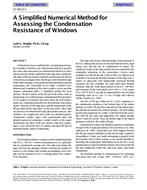Description
Methods have been established for calculating heat transfer in windows whereby a one-dimensional analysis is used for the center-glass area and a two-dimensional numerical calculation is used to model conduction in the edge-glass and frame. The effect of fill gas motion cannot be seen because the fill gas is treated as an opaque solid. The fill gas cools the bottom edge of the indoor glazing, so the predicted minimum indoor glazing temperature will consistently be too high. A detailed two-dimensional simulation of the entire window can be used but requires substantial effort. A simplified method has been devised. The flow pattern of the fill gas in the entire cavity is found using a two-dimensional computational fluid dynamics (CFD) analysis of natural convection where the wall temperatures are established using the one-dimensional center-glass model. Velocities in the edge-glass and the temperature of the fill gas entering the edge-glass section are noted. These data are used in a two-dimensional edge-glass/frame analysis. This method is not complicated and results are obtained quickly. Temperature profiles agree with experimental data and detailed numerical simulation. Sample results in this paper demonstrate the effect of fill gas motion, edge-seal conductance, a low-emissivity (low-e) coating, and argon fill gas on minimum indoor surface temperature.
Units: Dual
Citation: Symposium, ASHRAE Transactions, 1998, Vol 104, pt. 1A, San Francisco
Product Details
- Published:
- 1998
- Number of Pages:
- 8
- File Size:
- 1 file , 250 KB
- Product Code(s):
- D-7881




